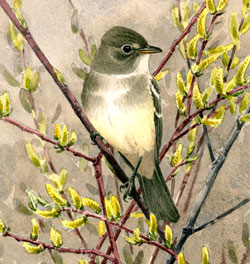Breeding Bird Atlases (BBA)
Find a Bird - BBA1
Breeding Bird Atlas 1 Species Accounts
Willow Flycatcher
Empidonax traillii
Egg Dates
June 27 to July 22
Number of Broods
one; may re-lay if first attempt fails.

The Willow Flycatcher was historically more western and southern in distribution than the very closely related Alder Flycatcher (see discussion under that species). Stein (1958) demonstrated that a substantial area of sympatry existed and that the Willow Flycatcher appeared to be aggressively displacing the Alder Flycatcher in many areas, particularly in lowland country in central New York State. This area of sympatry expanded markedly into the Northeast in the 1960s. Willow Flycatchers, once treated as a western song type of the Traill’s Flycatcher, were apparently recognized in Massachusetts at least as far back as the early 1930s, but they were not commonly encountered.
In the 1960s, Willow Flycatchers began to turn up more frequently, and range expansion occurred rapidly eastward across the state. Atlas data reveal that the Willow Flycatcher has virtually replaced the Alder Flycatcher in many of its traditional haunts, particularly throughout eastern Massachusetts and in the Connecticut River valley. The former is now a widespread and locally common nester on most of the mainland, probably even on lower Cape Cod. It is particularly well established in Essex and Middlesex counties and in the lower Connecticut River valley. It nests somewhat more sparingly over the central and western uplands, with noticeable concentrations in broad river valleys of the interior. It is very thinly distributed in the southeastern part of the state and absent from the Islands as a confirmed nester.
The sneezing fitz-bew advertising song is the surest indication of the Willow Fly-catcher’s presence. The birds also give a single creet and a whit call note. Arrival in Massachusetts occurs very close to that of the Alder Flycatcher, about the third week of May.
There is clearly some overlap with the Alder Flycatcher in habitat preference, with the Willow Flycatcher favoring the same alder-dogwood-viburnum thicket associations, but usually in more low open country such as expansive meadows, salt-and freshwater marshes, and broad river floodplains. Territories sometimes develop near those of the Alder Flycatcher, and it is not uncommon to encounter the two species within hearing range of each other. The distinctive calls apparently are important in keeping these otherwise very similar congeners reproductively isolated.
Nests are built in an upright fork of a shrub, often in Elderberry or a species of viburnum, and are generally located 2 to 9 feet above the ground. Four Massachusetts nests were located as follows: 1 in an alder at 6 feet, 1 in a Red Maple at 7 feet, 2 in a Box Elder at 4 and 5 feet, respectively (CNR, Meservey). Nests are neatly and tightly constructed, frequently containing cottony tufts of cattail, fine grasses, and the silky material of aspens and willows.
Clutches consist of three to four eggs, laid at 24-hour intervals until the set is complete. Clutches of 5 Massachusetts nests were as follows: two eggs (1 nest), three eggs (2 nests), four eggs (2 nests) (CNR, Kroodsma). Incubation begins when the last egg is laid and continues for 13 to 14 days. One brood is raised each year, but the birds will renest. The young are altricial and fledge at approximately 14 days of age. Massachusetts dates for nestlings have been reported from July 12 (three hatched) to July 25 (three nestlings) (Kroodsma, CNR). Later dates would be expected for successful renesting attempts. Data for fledglings is lacking. Virtually nothing is known of post-fledging events. After early July, singing abruptly ceases, and the birds once more join the ranks of anonymous Empidonax. Departure is presumably in early to mid-September. The wintering grounds are in Middle America from Vera Cruz and Oaxaca south to Panama and possibly farther south (see Alder Flycatcher account).
Map Legend and Data Summary
Atlas 1 data collected from 1975-1979


Note: fairly common in brushy meadows, especially in river valleys
Bradford G. Blodget



